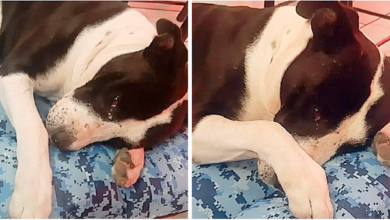Should You Allow Your Dog To Sleep On Your Bed?

Do you often find yourself sharing your bed with your furry companion? It’s no secret that many dog owners allow their dogs to sleep on their beds, but is it really a good idea?
While there are definitely some benefits to co-sleeping with your dog, there are also some potential drawbacks that you should be aware of before making this decision.
On one hand, allowing your dog to sleep on your bed can provide a sense of comfort and security for both you and your pet. Studies have shown that sleeping with a dog can help reduce stress levels and promote feelings of relaxation. Additionally, having your dog close by at night can create a stronger bond between you and your furry friend.
However, there are also concerns about hygiene, disrupted sleep patterns, and behavior issues that may arise from co-sleeping. In this article, we will explore the pros and cons of allowing your dog to sleep on your bed, as well as some factors to consider before making this decision.
- Benefits of Allowing Your Dog to Sleep on Your Bed
- Potential Drawbacks of Co-Sleeping
- Factors to Consider when Deciding Whether to Allow Your Dog to Sleep on Your Bed
- Tips for Keeping Your Bed Clean and Hygienic
- Alternative Sleeping Arrangements for Your Dog
- How to Train Your Dog to Sleep in Their Own Bed
- Conclusion
Benefits of Allowing Your Dog to Sleep on Your Bed
You’ll love the snuggles and warmth that come from allowing your furry friend to sleep on your bed. Besides the comfort factor, there are also some health benefits associated with co-sleeping with your dog.
Studies have shown that having a pet in bed can help reduce stress levels, lower blood pressure, and even improve overall sleep quality. In addition to the physical benefits, sleeping with your dog can also strengthen the emotional bonding between you and your furry companion.
Snuggling up together at night releases oxytocin, which is often referred to as the ‘love hormone.’ This chemical release promotes feelings of happiness and affection towards both you and your dog. However, it’s important to note that there are potential drawbacks to co-sleeping with your pet.
While rare, dogs can transmit diseases through close contact such as sleeping in the same bed. Additionally, if not trained properly or if they have behavioral issues, sharing a bed with your dog may lead to disruptions in sleep or even accidents during the night.
Potential Drawbacks of Co-Sleeping

Although cuddling with your furry friend can be comforting, there are two sides to every coin and co-sleeping with a canine companion may have its fair share of downsides.
One potential drawback is the risk of allergies. Some people develop allergic reactions to dog fur, saliva or dander which can cause skin rashes, sneezing or respiratory problems. Additionally, allowing your dog on your bed may increase the amount of allergens in your sleep environment.
Another potential drawback of co-sleeping is disrupted sleep patterns. Dogs may snore, move around frequently or wake up for bathroom breaks during the night which could disturb your restful slumber. Furthermore, behavioral implications must be considered as well. Co-sleeping may lead to negative behaviors such as territorial aggression or separation anxiety when the pet is not allowed on the bed.
Hygiene is also a concern when it comes to dogs sleeping on human beds. Dogs go outside and track in dirt and germs that can accumulate on their fur and paws which then gets transferred onto bedding and linens. This could potentially lead to skin infections or other health issues if not properly addressed through regular cleaning routines.
Ultimately, these factors should be taken into consideration before deciding whether allowing your dog to sleep on your bed is right for you and your furry companion.
When deciding whether it’s appropriate for you and Fido to share a sleeping space, there are several factors worth considering such as size of the dog breed, frequency of allergies or illness between both parties involved as well as personal preferences regarding cleanliness levels within household environments.
Factors to Consider when Deciding Whether to Allow Your Dog to Sleep on Your Bed
Factors to consider when deciding if Fido can snuggle up with you include the size of your pup, how often allergies or illness occur, and personal preferences for cleanliness in the home.
Large dogs are not ideal bedmates as they can take up too much space and disrupt your sleep quality. Smaller dogs may be a better option, but it’s important to note that their movements during the night can still disturb your sleep.
Health concerns should also be taken into consideration. If you have allergies or respiratory issues, allowing your dog on the bed could exacerbate these conditions. Additionally, some illnesses such as ringworm and fleas can easily spread from pets to humans through close contact like sleeping together.
However, if you do decide to allow your furry friend on the bed with you, there are ways to maintain hygiene and minimize health risks. In the next section, we will discuss tips for keeping your bed clean and hygienic without sacrificing cuddle time with your beloved pet.
Tips for Keeping Your Bed Clean and Hygienic
To maintain a clean and hygienic sleeping environment, it’s important to implement certain strategies when sharing your bed with your furry friend.
First, make sure your dog is regularly groomed and free of fleas or ticks. This can help prevent the transfer of any unwanted pests onto your bedding.
Additionally, consider placing a washable blanket or cover over your sheets that can be easily removed and washed on a regular basis.
In terms of cleaning routine, it’s important to regularly wash your bedding and vacuum any hair or debris that may accumulate from having your dog sleep in the same space. Consider investing in a high-quality vacuum specifically designed for pet hair removal.
It’s also recommended to have separate bedding designated solely for you and your dog to avoid cross-contamination.
While these strategies can help maintain bed hygiene when allowing your dog to sleep with you, it’s important to consider alternative sleeping arrangements for times when cleanliness is particularly important or necessary. This could include setting up a comfortable bed in another room or crate training your pup for nights when they need their own space.
Alternative Sleeping Arrangements for Your Dog
Consider exploring other sleeping options for your furry companion to ensure both you and your dog have a comfortable and hygienic rest. While some pet owners may prefer to have their dogs sleep on their beds, there are alternative sleeping arrangements that can provide just as much comfort.
One option is investing in a quality dog bed that suits your pet’s size and sleeping habits. There are many dog bed options available in the market, including orthopedic beds for older dogs with joint problems, heated beds for cold winter nights, and cooling beds for hot summers.
Another alternative is creating a designated nighttime space for your pet within your bedroom or another suitable area of the house. This space should be equipped with comfortable bedding, toys, and water bowls to make it inviting for your furry friend. You can also establish a nighttime routine by setting specific times when it’s time to sleep and wake up. Consistency is key when establishing these routines since dogs thrive on predictability.
By providing alternative sleeping arrangements for your dog, you not only ensure they have a good night’s rest but also minimize hygiene issues associated with allowing pets on human bedding.
In the next section, we’ll discuss how to train your dog to sleep in their own bed without disrupting their routine or causing stress.
How to Train Your Dog to Sleep in Their Own Bed
Now that we’ve discussed alternative sleeping arrangements for your dog, let’s talk about how to train your furry friend to sleep in their own bed.
Crate training is a great way to help your pooch feel comfortable and secure in their own space. A crate can serve as a safe haven for your dog, providing them with a sense of security and privacy.
To start crate training, choose a crate that’s the appropriate size for your dog and place it in a quiet area of your home. Introduce the crate gradually by placing treats, toys, or blankets inside to entice them. Once they’re comfortable going in and out of the crate, you can begin closing the door for brief periods of time while you’re at home.
Remember to always use positive reinforcement such as treats and praise when they enter or exit the crate. As with any successful training method, patience is key when it comes to teaching your dog to sleep in their own bed.
Be consistent with training sessions and reinforce good behavior with rewards. With time and effort, you’ll be able to enjoy peaceful nights without feeling guilty about letting your pup sleep on the bed!
Conclusion
So, should you allow your furry friend to snuggle up with you in bed? The answer is simple: of course not. Unless, of course, you enjoy being covered in fur and waking up to the sound of doggy snores.
While there are some benefits to co-sleeping with your pup, such as increased feelings of comfort and security, there are also potential drawbacks like allergies and disrupted sleep. And let’s not forget about the hygiene concerns – do you really want to share your sheets with a creature that rolls around in dirt all day?
But don’t worry, there are alternative sleeping arrangements for your pooch that will keep both them and your bed clean and comfortable. And with proper training, they can learn to love their own cozy bed just as much as yours.
So next time Fido gives you those puppy-dog eyes and begs for a spot on the mattress, remember – it’s best for everyone if they stick to their own sleeping quarters.
Read more:


















































